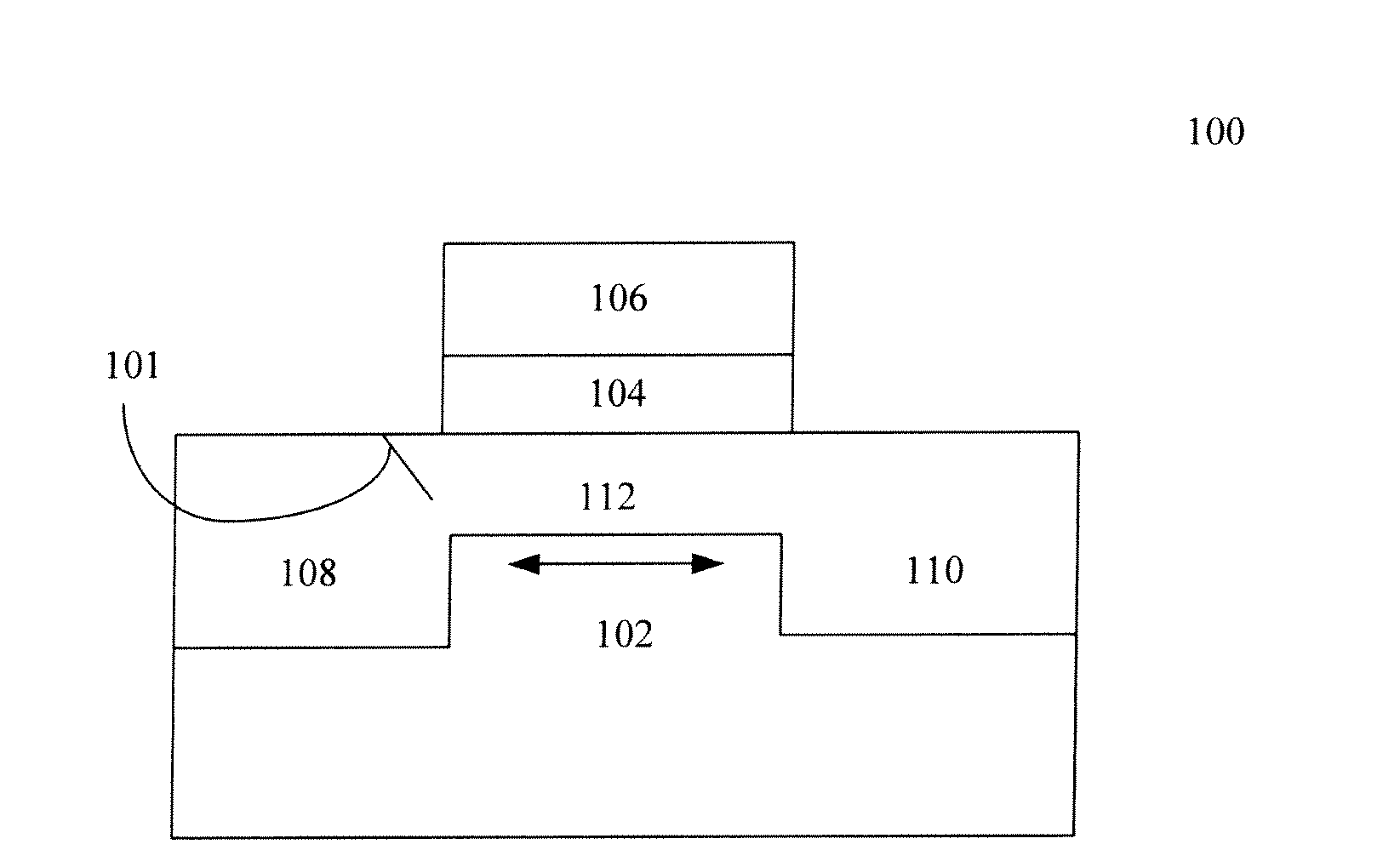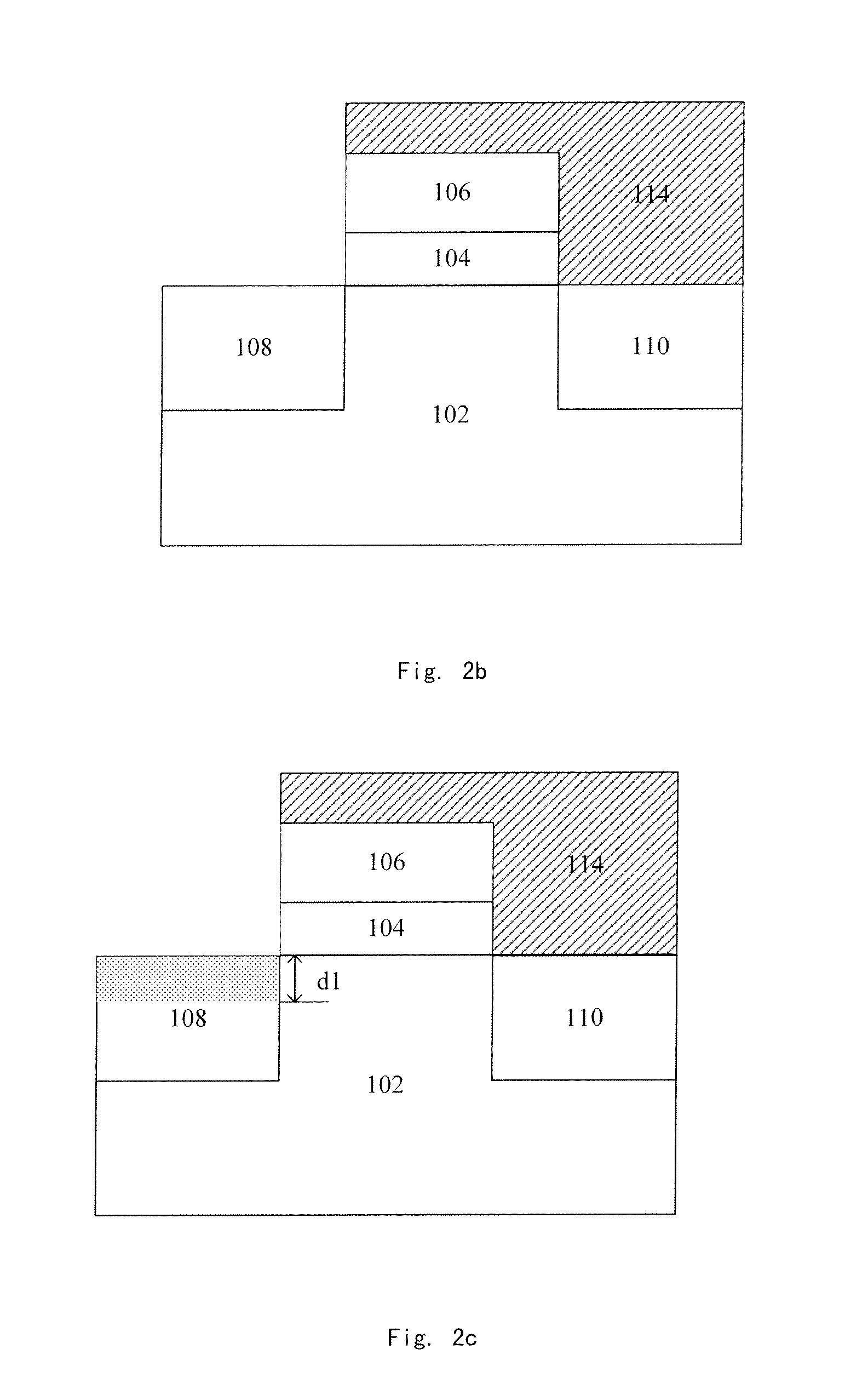Transistor and method for forming the same
- Summary
- Abstract
- Description
- Claims
- Application Information
AI Technical Summary
Benefits of technology
Problems solved by technology
Method used
Image
Examples
first embodiment
The First Embodiment
[0033]FIG. 1 schematically illustrates a transistor according to the first embodiment of the present invention. As shown in FIG. 1, a transistor 100 comprises a semiconductor substrate 102, a gate dielectric layer 104 formed on the semiconductor substrate 102, a gate 106 formed on the gate dielectric layer 104, a source region 108 and a drain region 110 in the semiconductor substrate 102 and on respective sides of the gate 106, and a channel region 112 under the gate dielectric layer 104 and between the source region 108 and the drain region 110. In the transistor 100 shown in FIG. 1, the source region 108 comprises a dislocation 101 adjacent to the channel region 112. The dislocation 101 applies tensile stress (as indicated by the arrow in the figure) to the channel region 112, which increases the electron mobility in the channel region.
[0034]In addition, the transistor 100 further comprises sidewall spacers formed on the side surfaces of the gate dielectric lay...
second embodiment
The Second Embodiment
[0039]FIG. 3 schematically shows a transistor according to the second embodiment of the present invention. The transistor 200 shown in FIG. 3 is different from the transistor 100 shown in FIG. 1 in that there are two dislocations in the source region 108 in the direction parallel to a top surface of the substrate 102. Although the dislocations are shown not to intersect each other in FIG. 3, the dislocations may intersect each other.
[0040]The method for forming the transistor 200 is similar to that for forming the transistor 100. First, a mask layer 114 is formed on a semiconductor substrate 102 on which a gate dielectric layer 104 and a gate 106 have been formed, so that the mask layer 114 covers the gate 106 and the semiconductor substrate 102, which is the same as the step shown in FIG. 2a of the first embodiment and thus is not shown here. Next, the mask layer 114 is patterned so that only a portion of the source region 108 is exposed, as shown in FIG. 4a. P...
third embodiment
The Third Embodiment
[0044]FIG. 6 shows the transistor according to the third embodiment of the present invention. The transistor 300 shown in FIG. 6 is different from the transistor 100 shown in FIG. 1 in that the source region 108 comprises a set of two dislocations which are adjacent to the channel region 112 and arranged in the direction perpendicular to the top surface of the semiconductor substrate 102.
[0045]Accordingly, as compared with the method for forming the transistor 100 in the first embodiment, the method for forming the transistor 300 according to the present embodiment further comprises performing a second ion implantation with a second implantation depth of d2 to the source region 108 after the annealing step of the method of the first embodiment, with the second implantation depth d2 being smaller than the first implantation depth d1, as shown in FIG. 7. An annealing is performed after the second ion implantation and the device shown in FIG. 6 is obtained. The impl...
PUM
 Login to View More
Login to View More Abstract
Description
Claims
Application Information
 Login to View More
Login to View More - R&D
- Intellectual Property
- Life Sciences
- Materials
- Tech Scout
- Unparalleled Data Quality
- Higher Quality Content
- 60% Fewer Hallucinations
Browse by: Latest US Patents, China's latest patents, Technical Efficacy Thesaurus, Application Domain, Technology Topic, Popular Technical Reports.
© 2025 PatSnap. All rights reserved.Legal|Privacy policy|Modern Slavery Act Transparency Statement|Sitemap|About US| Contact US: help@patsnap.com



